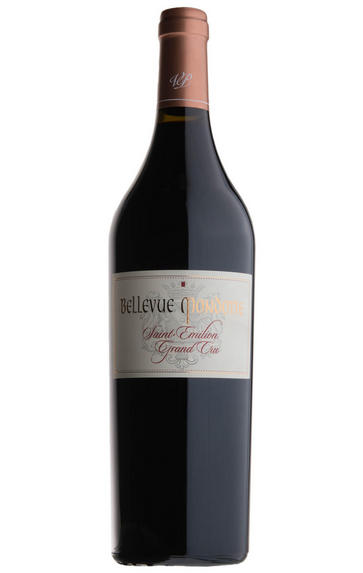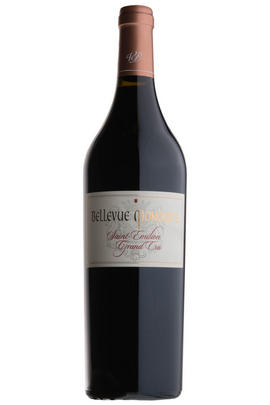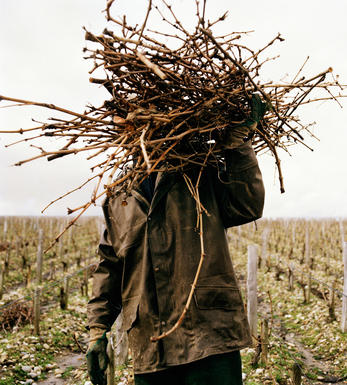
2011 Château Bellevue Mondotte, St Emilion, Bordeaux

Critics reviews
Robert M. Parker, Jr. - 30/04/2014
Wine Spectator's 2011 Top-Scoring Red Bordeaux
(James Molesworth, Wine Spectator, April 5, 2012)
(Robert Parker - Wine Advocate - April 2012)
About this WINE

Bellevue Mondotte
Chateau Bellevue Mondotte is a tiny, 2-hectare wine property on the limestone plateau of St Emilion, bought in 2001 by Gérard Perse, owner of the celebrated premier Grand Cru Classé Ch. Pavie.
Merlot comprises over 90% of the blend with a dash of both Cabernet Sauvignon and Cabernet Franc. The vineyard faces south at an altitude of 80 metres above sea-level, and the average age of the vines is 45 years.
The wine falls very much into the garagiste camp, being aged in 100% new oak and produced from tiny yields of 15-20 hectolitres per hectare.
Michel Rolland is the consultant oenologist. After 6 months ageing on its lees the wine remains in barrel for a further 18 months before being bottled unfiltered and unfined.

St Émilion
St Émilion is one of Bordeaux's largest producing appellations, producing more wine than Listrac, Moulis, St Estèphe, Pauillac, St Julien and Margaux put together. St Emilion has been producing wine for longer than the Médoc but its lack of accessibility to Bordeaux's port and market-restricted exports to mainland Europe meant the region initially did not enjoy the commercial success that funded the great châteaux of the Left Bank.
St Émilion itself is the prettiest of Bordeaux's wine towns, perched on top of the steep limestone slopes upon which many of the region's finest vineyards are situated. However, more than half of the appellation's vineyards lie on the plain between the town and the Dordogne River on sandy, alluvial soils with a sprinkling of gravel.
Further diversity is added by a small, complex gravel bed to the north-east of the region on the border with Pomerol. Atypically for St Émilion, this allows Cabernet Franc and, to a lesser extent, Cabernet Sauvignon to prosper and defines the personality of the great wines such as Ch. Cheval Blanc.
In the early 1990s there was an explosion of experimentation and evolution, leading to the rise of the garagistes, producers of deeply-concentrated wines made in very small quantities and offered at high prices. The appellation is also surrounded by four satellite appellations, Montagne, Lussac, Puisseguin and St. Georges, which enjoy a family similarity but not the complexity of the best wines.
St Émilion was first officially classified in 1954, and is the most meritocratic classification system in Bordeaux, as it is regularly amended. The most recent revision of the classification was in 2012

Cabernet Sauvignon Blend
Cabernet Sauvignon lends itself particularly well in blends with Merlot. This is actually the archetypal Bordeaux blend, though in different proportions in the sub-regions and sometimes topped up with Cabernet Franc, Malbec, and Petit Verdot.
In the Médoc and Graves the percentage of Cabernet Sauvignon in the blend can range from 95% (Mouton-Rothschild) to as low as 40%. It is particularly suited to the dry, warm, free- draining, gravel-rich soils and is responsible for the redolent cassis characteristics as well as the depth of colour, tannic structure and pronounced acidity of Médoc wines. However 100% Cabernet Sauvignon wines can be slightly hollow-tasting in the middle palate and Merlot with its generous, fleshy fruit flavours acts as a perfect foil by filling in this cavity.
In St-Emilion and Pomerol, the blends are Merlot dominated as Cabernet Sauvignon can struggle to ripen there - when it is included, it adds structure and body to the wine. Sassicaia is the most famous Bordeaux blend in Italy and has spawned many imitations, whereby the blend is now firmly established in the New World and particularly in California and Australia.


Buying options
Add to wishlist
Description
A little gem of an estate owned by the Perse family, the 2011 Bellevue Mondotte is composed of 90% Merlot, 5% Cabernet Sauvignon and 5% Cabernet Franc. This super, highly concentrated wine (please dont make the mistake of saying over-extracted as there is not a bit of bitterness to be found) is the product of tiny yields and a late harvest. A thick, port-like, black/ruby/purple color is followed by a powerful, rich, exceptionally pure wine with stunning balance. From a vintage where most wines will need to be consumed within their first 15-20 years of life, this cuvee will undoubtedly last 30 or more.
Robert M. Parker, Jr. - 30/04/2014
wine at a glance
Delivery and quality guarantee